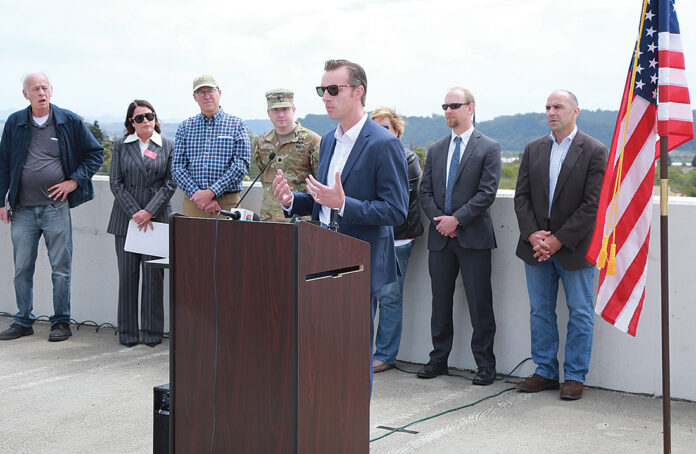WATSONVILLE—After years of wrangling by local, state and federal lawmakers—and of worries from residents of another catastrophic flood in South Santa Cruz County—the Pajaro River levee has enough money for a long-awaited upgrade that could offer a century’s worth of protection.
But while the construction funds for the $400 million project are secured, the project’s fate lies in the hands of roughly 3,000 residents who live in the floodplain.
To allow the U.S. Army Corps of Engineers to secure the funding, the residents must answer “yes” on ballots that will be mailed out to property owners on April 22.
That would mean placing an assessment on their annual property tax bills—averaging around $192—that would fund the annual $1.2 million in maintenance and operations funds still needed for the project.
Failure would be the death knell of the project, at least for now.
In a Monday lunchtime press conference led by Rep. Jimmy Panetta, who helped spearhead a recent $67 million infusion of federal funding for the construction, several elected leaders put out a plea to the public: vote “yes” on the assessment.
While getting the money was a critical step in the long-awaited project, it is not the final chapter, said Santa Cruz County Supervisor Greg Caput, whose district covers much of Watsonville.
“We will celebrate only after the election,” he said. “They have to say ‘yes’ on this, that’s the most important part. Otherwise, the money will go away.”
The press conference was also attended by Watsonville Mayor Ari Parker, and Santa Cruz County Supervisor Zach Friend and Pajaro Regional Flood Management Agency Director Nancy Bilicich, both of whom have been at the forefront of bringing the project to fruition.
Also in attendance was John Martinelli, whose eponymous company depends on apple crops grown in the Pajaro Valley.
Martinelli said that he has for years been part of unsuccessful local efforts to secure funds for levee upgrades.
“That was a nonstarter,” he said. “This community simply can’t afford that kind of a cost. Now we have a fully funded $400 million project.”
A large flood, Martinelli said, is estimated to cause $1 billion in damage, and could occur as often as once per year.
“Something like that would devastate our company,” he said. “You can’t get enough insurance to compensate for something that destroys your business.”
Judy Lazenby, who lives in Pajaro Village—an older adult community with 247 residences in the river’s floodplain—said she normally sides with those who oppose extra taxes. This is not one of those times, she said.
“We do need protection a lot more than we need to keep cutting taxes,” she said.
Assessments are “fair” at around $200, she said.
Lazenby said that the project—once completed—will mean that flood insurance requirements for many residents will go away.
“Believe it or not, floods can be prevented,” she said. “Tornadoes can’t be, hurricanes can’t be, but this can be and we need to do that. The likelihood of a flood may be small, but it won’t take much to take the levees out.”
Patrick Messinger, who sits on the homeowners’ association of the Bay Village neighborhood, which comprises 600 homes, says he plans to go on a door-to-door campaign to advocate for the assessment.
“It is critical that we get this done,” he said.
The ballots will be mailed on April 22, and are due by June 8. The final results will be announced at the July 13 PRFMA meeting.Property owners who want to see how much they would pay can visit prfma.org/assessment, and click on “Calculate Your Assessment.” An Assessor’s Parcel Number is needed for this search. To find that, visit bit.ly/3xHledJ.







